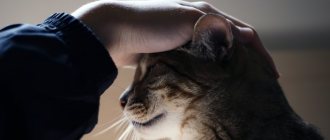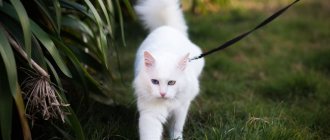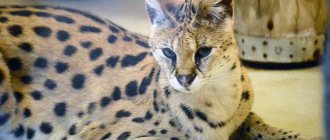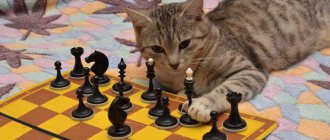People at all times have been touched by one type of cat animal, be it representatives of wild or domestic cats. Moreover, in nature, there are many species of cats that are unusual and amazing in appearance. Here are some of them: May Coon, Caracal, Pallas's Cat, Savannah, Sand Cat, Serval, Serengeti, Chausie, American Wirehair.
We are considering two rare species of wild cats that are on the verge of extinction.
Serval (Leptailurus serval) – long-legged bush cat
The body length of this large animal can reach 135 cm, it grows in height up to 65 cm, and the weight of males can reach up to 20 kg. Distinctive features are long legs, a small head, rounded erect ears and spotted coat color. In the wild, the bush cat lives in Africa (with the exception of desert areas).
Animals settle near water bodies and hunt in tall grass. They jump well in height and catch birds in the air, get rodents out of their shelters, and know how to swim.
Servals are incredibly beautiful and graceful cats, which are increasingly being taken as a pet.
Savannah
This breed was the result of crossing a cat and an African serval. It remains one of the most expensive in the world, because only a professional breeder can get offspring from a predator and a pet. Breeders have been working on creating savannas for more than ten years. As a result, the first kittens were born at the end of 1980. In 2001, the breed was officially recognized and registered by the International Cat Association. These pets are quite large; their height at the withers can reach 60 cm. Since childhood, kittens have the claws on their front paws removed with a laser, this is done so that they do not accidentally scratch their owner. The cost of a kitten varies from 15 to 20 thousand dollars. However, if you think that for such a price an animal will live in your house, over which you will need to shake like a crystal vase, you are mistaken. Savannahs are not picky about their care.
Savannah cat. Photo: wikipedia.org
Caracal, or steppe lynx (Caracal caracal) - a cat with the color of a puma
The name of this species comes from the Turkic word “karakulak”, which translates as “black ear”. The fact is that these animals have dark ears at the back (outside).
The animal looks like a smaller copy of a lynx (it also has tufts on the tips of its ears), but its sandy coat is more reminiscent of a puma (Puma concolor). Body length – 65-80 cm, height – up to 45 cm, body weight – up to 20 kg. The steppe lynx hunts birds (including baby ostriches), rodents, hedgehogs, and foxes.
The caracal crosses well with the African serval. As a result, currently there are servikal and karval.
Caracal
Save Status
The caracal is listed as "Least Concern" , despite population trends being unknown across much of the steppe lynx's geographic range. They are considered rare or endangered only in Asia and North Africa, and are considered nearly extinct in India.
Although the caracal is protected by law in many countries, its populations are threatened by widespread habitat destruction for agricultural development or road construction, poaching for fur or meat, the trade in exotic animals, and conflicts with farmers.
Keeping domestic servals and caracals
Domesticated cats, which were raised in special nurseries, are friendly and gentle, however, due to their very large size, it is not recommended to have them for families with children under 5-6 years of age. After all, a pet can seriously scratch if the child is too annoying. Cats can be cautious and even timid with strangers, but they love to play with their owners, fetch a ball, and are able to learn several commands.
These large pets are kept in a private house with an enclosure, as the animal needs active walks. Cohabitation with rodents, parrots, canaries and ferrets is impossible, since the hunting instinct will inevitably make itself felt.
Animals do not require special care. Like all cats, they clean their own fur. To prevent harmful insects from settling on your pet’s body, we recommend drops against fleas and ticks. Since animals consume mainly raw meat and bones, it is necessary to carry out prophylaxis against worms (more about the drugs). For entertainment, you can build a swimming pool in the courtyard of your house. The tray can be ordinary, but larger.
Average life expectancy is 13-18 years. Pets are vaccinated with cat vaccines. (More about cat diseases and types of vaccines in the blog)
Caraquets ®
- Caraquet – who is this?
- Is the Caraquet breed?
- History of the appearance of caracets
- About working on the program
- Caraquet F1 VIPLEO (75%)
- Caraquet F1 VIPLEO (50%)
- Caraquets F3 VIPLEO
- Caraquets F4 VIPLEO
- Feeding
- Sounds that caraquets make
- The F1 caraquet kids are sleeping sweetly...
- About education...
- Tray, toys, scratching posts...
Author: Kuzmina Anna Date: 01/08/2018
Caraquet – who is this?
At the moment (03/20/2018) there are only caracat hybrids of the first and second generations (Caracat F1 and F2). I’ll tell you in order what this means, since many questions arise on this topic.
First generation kittens (first generation) must have at least 50% wild blood from the feline species (for example, serval, caracal, jungle cat, ALC). In our case, the F1 caracat must have at least 50% caracal blood. To get an F1 Caracat, one of the parents must be a Caracal. In our VIPLEO® nursery, this role is played by the male. This means that our F1 Caracat kittens have a Caracal father, and the mother is an ordinary purebred cat, since F3 Caracat females and later generations do not yet exist. And they are also needed in the correct type, color and size (which is what breeders of F1 and F2 Caracat cats are currently working on). The role of mother at the moment can be any breed or a cross of breeds suitable in type, color, size. Often they use the Abyssinian breed or its cross with other breeds (since the Abyssinian in its “pure form” is a very small cat for a caracal), the Chausie and its cross, the Oriental and its cross, etc. Our nursery also uses these breeds and crosses of breeds.
Caracal and caracat of VIPLEO nursery
What does caraket F2 mean? This means that the kitten must have at least 25% wild ancestor blood. In the pedigree of F2 Caracats, the caracal is the grandfather on the mother's side. Due to the fact that fertile male caracats do not yet exist (the first generations of males in hybrids are usually sterile), a male suitable in type, color and size from other breeds or a cross between breeds is selected as the father for F2 caracat kittens. Now work is underway to obtain later generations of F3, and subsequently F4, F5, as well as to obtain fertile male caracats. As a result of this complex and painstaking work, it is very important not to lose the beauty, type, color, tassels, and also to preserve the maximum size from the caracal ancestor! Next, it will be possible to prepare for the recognition of the Caraquet breed and its removal from the category of experimental.
A frequently asked question is: is the Caraquet breed?
I decided to make a short video and voice it, since some questions are asked very often and it’s difficult for everyone to answer the same thing in PMs and comments. These are the first generation hybrids from the caracal - caracat F1. This means that their father is a caracal, and their mother is a purebred cat. In our case, in the video, the kittens’ mother’s breed is Chausie, and our father is a young and large male caracal, whose current weight is 22 kg, he is an affectionate and completely adequate cat. Mom is an extremely affectionate and friendly cat, her weight is around 4-4.5 kg. Also in our cattery cats of other breeds and mixed breeds the CARAKET program
Due to the difference in size and a number of other features, it is very difficult to get F1 Caracat kittens and many breeders fail. Therefore, at the moment, in the whole world there are only two breeders producing F1 Caracat kittens and we are very proud of this. They are truly the most unique and rare cats in the world. Unlike servals and caracals, which we do not recommend and do not sell for apartments, caracat kittens can be kept in an apartment, live with other cats and dogs, as well as in families with small children. In the following videos I will tell you a little about feeding, maintenance, toys, scratching posts, etc.
Today, work is underway on a program for breeding the experimental breed CARAKET . But there is no breed and there cannot yet be. Only the first generations of hybrids have been obtained (Caraket F1 and F2). The breed is still far away... First, you need to get fertile male Caracats, reach the fifth generation (Caracat F5) and still invest a lot of effort and labor so that it is recognized as a breed and taken out of the experimental category. Therefore, it is incorrect to assert that the breed already exists, and even more so to proclaim someone as the “creator of the breed” Caraquet... This misleads people, gives incorrect information and looks like a deception. Yes, this is a long but interesting path and I really hope that over the years it will be possible to develop the breed and it will be recognized. Then we will all admire the beautiful Caraquets as a breed, but at the moment only hybrids are born. And it doesn’t matter who exactly breeds the breed, it is important that it exists and they look great, and in appearance they are similar to the ancestor of the caracal.
History of the appearance of caracets
The history of the appearance of caracats supposedly, according to unknown facts, began in 1998, when in the Moscow Zoo (Russia) offspring were unexpectedly born from a caracal cat and a domestic cat of an unknown breed. According to unverified information, an ordinary cat entered the enclosure in which a male caracal was kept, and soon gave birth to a kitten with tufts on its ears and an unusual color, close to the color of a caracal.
The second fact of the birth of F1 caracets dates back to 2007. Then the American breeder, the first and only breeder in the world (as of the indicated date) Joy Geisinger , who later became the curator of the experimental Caracat breed at the international cat association TICA, invested a lot of effort and labor in its promotion.
It was she who carried out the planned crossing of a domestic Abyssinian cat and a Caracal cat, as a result of which the offspring of first generation kittens (Caracat F1) were obtained. Unfortunately, in 2008, Joy died of a sudden heart attack and work in this direction was suspended. Caracat F2 Date of birth: April, 2011 Breeder: Allison Navarro Owner: Teralee A. Harral Photo: September, 2018
Later, thanks to the work of another breeder Allison Navarro (pictured), it was possible to obtain first and second generation hybrids from the caracal - caracat F1 and F2 . Due to current life circumstances, further work on the development of the experimental caraquet breed and other savannah hybrids (which she also successfully worked on) Allison Navarro was suspended in 2015. The caracat kittens obtained as a result of this work still delight their owners.
In Russia in 2014, the first generation F1 hybrids were born. Then these wonderful kittens appeared in Ukraine.
At the moment, our VIPLEO® nursery is one of only two in the world that can produce these precious kittens. In addition, today there are several successful breeders in Russia working to produce F2 Caracats. Our nursery also works towards obtaining decent F2 caracats that are suitable in type, size and color.
We hope for successful continuation of work on the future breed by all Caraquet breeders and wish us all good luck!
About work on the program “Caraquet of our nursery VIPLEO®”
It turns out that we were the first in the world to receive CITES for Caracat F1 ! The first legal Caracat kittens with a full package of documents were born in our nursery! In addition, all Caracat kittens born in our VIPLEO® nursery have a state confirmation of the birth of first-generation hybrids from a caracal (caracal and domestic cat) and second generation (female first-generation hybrid from a caracal and a domestic cat)! All Caracat F1 and F2 are registered with TICA , and this is already more than 20 individuals. We manage to get very beautiful, large, pre-registered experimental breed standard Caraquet kittens. And more additions are expected soon!
Our VIPLEO® nursery officially operates under the Caraquet . The nursery is constantly working to obtain suitable females and males for the Caraquet program . This is very responsible and takes a lot of time, effort and patience. But at the same time, it is a very interesting and enjoyable job. Observing the results, you want to invest and develop even more. The results of our work are displayed in both TICA and CITES , since we are dealing with hybrids and, first of all, all our successes must be recorded officially, without breaking the law. Our Caracat kittens since 2015 have all state documents, acts, origins, official registrations. OUR CARAQUETS are the FIRST in the WORLD (!!!) cats that are registered in the international organization CITES . These are the first legal Caracat kittens in the world! Since 2016, we have regularly received CITES for our Caracat kittens.
CITES Certificates
We are intensively working on the “Karaket” program: publications in magazines, on Internet resources, at exhibitions and television programs, and there is still a lot of interesting work ahead. A lot of work has already been done in the nursery to breed suitable males for producing F3 and F4 caracat . Thanks to this work, excellent caraquets F3 and F4 . There are many developments and plans for the future. We will inform you about the work of our nursery under the “Experimental Caraquet Breed” program.
F1 caraquets from VIPLEO kennel. Article “The first F1 caracats VIPLEO (75% caracal blood)”
2021 Wonder Girl HP F1-75%
Our VIPLEO graduate Nessie, F1 caracat (75% caracal blood). Age - 1 year.
Our graduate is VIPLEO Baby, F1 caraquet (75% caracal blood). Age - 1.3 years, weight - 15.9 kg.
Fortunella - caracet F1 VIPLEO (75% caracal blood)
Caracquet kitten F1 from VIPLEO cattery (75% caracal blood)
Caracats F1 from VIPLEO nursery (50% caracal blood)
Caraquets F3 VIPLEO
In the video and photo you can see girls of the second litter of F3 Caracats from VIPLEO®, born in the spring of 2022 (the first F3 litter in our nursery was born back in 2022).
The kittens perfectly retained all the characteristics of their caracal ancestor. Although it was very difficult to obtain kittens with such striking qualities in later generations. They are all good size and ticked. In addition, like the ancestor of the caracal, F3 kittens retain spots on their bellies and markings on their faces - vertical eyebrows and black whiskers. There are also tassels on the ears. All these F3 Caracat girls (like the girl from the 2018 litter) will participate in the future Caracat program.
Caraquet kitten F3 VIPLEO
Caraquets F4 VIPLEO
The first born F4 caracats turned out to be large in appearance, with the signs of their ancestor - the caracal. Cats have an excellent friendly character, they are people-oriented and love to be in the thick of things with the family. Today, one of the directions of our nursery is to work on improving and preserving the characteristics of the caraquet in later generations and obtaining a fertile male caraquet.
In 2022, our nursery managed to obtain not only the world's first F4 caracats, but also the first F4 caracats in blue color in 2020!
Caraquet kitten F4 VIPLEO
Feeding caraquet kittens
From mother's milk or bottled milk, kittens are transferred to minced meat made from either quail or turkey. Next, quail and turkey are given in pieces - from small to larger pieces. They also eat day-old chicks well, which, like quail, are very useful for both kittens and adult cats. We freeze all the meat and after defrosting, when the temperature reaches room temperature, the food is ready to eat, which is very important because... Cool or cold food should not be given. We also add vitamins and minerals to meat for meat-eating animals.
In America, hybrids of the first and subsequent generations are mainly fed grain-free food with a high meat content, and there is also a line of food for pure felines. They always have clean water freely available; we supply fresh water every day.
Sounds that caraquets make
Caracats hardly meow. They chirp, yelp, squeak - in general, they make any sounds other than typical cat sounds. Some kittens love to “communicate” and will be happy to “respond” to your words. And many caracats love to sit on their hands and purr - this “function” is so lacking in many domestic cats!
The F1 caraquet kids are sleeping sweetly...
The F1 caraquet babies are sleeping sweetly... These are babies from a caracal dad and a mother - a domestic purebred cat. From the caracal dad, the kittens inherited black ears (by the way, translated from Latin “Caracal caracal” means black ear), as well as spots on the tummy and a clean, spotless color on the body. If we talk about size, then at this age they are already much larger than ordinary kittens, which is also the merit of the caracal dad.
But in behavior they are much softer than caracals. And the mother cat tried to do this, not only reducing the size of the kittens relative to the caracal, but also improving their temperament, and also muffled the “wild” blood.
It is this characteristic feature that allowed F1 caracets (unlike caracals, which can only live in houses with an enclosure) to live in ordinary apartments, with small children and other animals.
The weight of an adult F1 caracat is about 10-15 kg. Males are usually larger than females.
Raising Caraquet Babies
This is how VIPLEO® children are raised from infancy. Constant communication with a person from birth is very important for any breed of kittens and especially for hybrids. Thus, people become family for them from the first days of their life.
Tray, toys, scratching posts...
As you can see in the video, they go to the litter box, just like regular cats. At the same age as in the video, we already install a large tray. We use wood filler. We have tried all types of cat litter. But due to the fact that many kittens, when exploring the world, play not only with toys, but also with filler, which they taste, we decided that wood filler is safer at a young age. It’s also good that as they grow up, they can easily switch from this filler to any other. If a new family wants to change the filling, there will be no problem. We buy different toys. If you buy in the cat department, you need to choose durable and high-quality toys, as there is a danger of chewing and swallowing small objects and parts. You can also find a lot of interesting things in the dog department. It’s not for nothing that they call us cat-dogs!
When kittens grow up, they play well with a plastic bottle, chase potatoes, apples and other suitable objects. Of course, you need to be careful about your kittens’ toys and change them on time. They love a variety of scratching posts - both with rope and croton. We also have rugs with hard weave hanging on the walls, which they love to jump on and scratch their claws well. If you choose a gaming complex, you need to take into account that the caracat is a large cat, so the complex must be well stable and fixed. The shelves should be large enough so that when the kitten grows up, it will be comfortable to lie on and safe to jump on. From childhood, there is no need to teach a kitten to play with your hand; use either a toy or waving sticks. Hands are only for affection!
Media
Contacts: (+38)0989668888, [email protected]
To the beginning of the article Back
Raising wild cats
Patience is especially useful in this matter. A little mustachioed friend is acquired at the age of 2-3 months. The serval and caracal kitten strives to try everything by tooth (like little puppies), so from childhood it needs to be taught the “No/Stop” command.
If the baby does not obey and continues, for example, to chew on wires, after a strict command, direct a stream of spray at him. This should catch you off guard and interrupt the unwanted action.
Don’t let him play with your limbs, otherwise the cat will not give up this fun even after he grows up. In addition, from an early age, get him accustomed to a leash and walks in the yard, because without physical activity he will be uncomfortable.
Serval coat hygiene
The serval's coat is quite thick, with a noticeable undercoat, so care for it must be regular and thorough. What you will need to care for a serval's coat:
- slicker,
- furminator for short-haired cats,
- rubber brush,
- a frequent comb or comb made of any material other than plastic.
The serval is groomed every day. The slicker is used once every 3 days, and the furminator - no more than once every 1.5 - 2 weeks. Combing order:
- The wool is smoothed with a comb or comb.
- A slicker brush combs the wool well. Once every 1.5 - 2 weeks, a furminator is used instead of a slicker.
- Then the cat is thoroughly combed with a rubber brush.
- The procedure is completed by combing the hair with a comb or comb.
You should not wash your Serval with shampoo more than once a month. For this, it is best to use a natural cat shampoo with herbal extract or a kitten shampoo, which contains fewer chemicals and is more gentle. Also, servals simply love bathing, so it will be useful to sometimes let him splash around in the bathtub with water. If you have access to a pool or clean body of water, do not deprive your pet of pleasure.
What shampoos are suitable for the Serval:
- Jerob Herbal,
- Perfect Coat Tearless kitten,
- BioGroom Kuddly Kitty,
- K9 Aloe Vera,
- Bio-groom So Gentle.
Photo gallery: shampoos for serval
Jerob Herbal is made from medicinal herbs
Perfect Coat Tearless kitten does not sting the eyes
BioGroom Kuddly Kitty does not contain harsh chemicals
K9 Aloe Vera nourishes and moisturizes the coat
Bio-groom So Gentle does not cause allergies
If your serval spends a lot of time outside, it should be treated with a no-rinse spray shampoo or dry shampoo. The product should be sprayed or poured onto the fur, then combed thoroughly and wiped with a slightly damp cloth.
Dry shampoos and sprays for Serval:
- Jerob Waterless,
- Pet Silk No Rinse,
- Anju Beaute Aisance Non-Rinse Cleaner,
- Pure Paws Dry spray and powder,
- Chris Christensen Dry Breeze.
Photo gallery: dry shampoos for serval
Jerob Waterless gently cares for the coat
Pure Paws Dry spray is effective, but cannot completely replace bathing
Pure Paws Dry must be completely combed out of the coat after use.
Anju Beaute Aisance Non-Rinse Cleancer contains substances that are beneficial for wool
Pet Silk No Rinse spray allows you to clean your cat's fur without bathing
How much does a serval and caracal cost?
Serval and caracal are very expensive, it all depends on the country, the status of the cattery, and the class of the kitten. For babies, breeders ask on average from 5 thousand USD. At the same time, at the age of six months it is strongly recommended to castrate/sterilize them, since it is very difficult to fight the marks.
If you become interested in these breeds of cats, keeping them in an apartment or at home is possible, the most important and main point will be its proper upbringing from a young age and proper, nutritious feeding, then these unrealistically beautiful animals will delight you with their natural beauty every day.
Spread range
Geographical distribution
The caracal has a very wide distribution, one of the most extensive of living carnivores, from the southern tip of the African continent, north to the Arabian Peninsula, the Middle East and Turkey, east to central India and further north to Kazakhstan and Turkmenistan.
Photo: Wikipedia
Its historical range has shrunk only on the periphery, where the caracal has suffered significant losses. In North and West Africa in particular, the caracal was exterminated en masse in areas with high rates of livestock land conversion. Experts estimate that it has lost 37.7% of its historical distribution . However, the steppe lynx is most common in South Africa and Namibia, where its range is expanding, possibly due to the extermination by farmers of the black-backed jackal, an enemy of the caracal. In Asia, these felines remain unevenly distributed and are limited to harsh winters, when the Himalayas act as a natural barrier preventing the predator from spreading further north.
Habitat
The caracal occupies a wide variety of landscapes and habitat types at altitudes ranging from sea level to 3,300 meters . However, preference is given to areas at an altitude of less than 1200 meters.
The steppe lynx can be found in arid forests, savannas, scrubland, hilly steppes, arid mountain ranges and on the edges of large sandy areas. Particularly in arid or semi-arid areas, it is most often found in dense vegetation on rocky slopes and in riparian habitats where rodent populations are high.
Photo: Justin Hawthorne
The caracal uses vegetation for cover when hunting and trees for shelter. It sticks to open areas during nocturnal activity and prefers denser thickets and rock crevices during the day. Vegetation offers the predator valuable shade while resting on hot days.
On the African continent, steppe lynxes generally avoid equatorial rainforests and open sandy deserts . In the Asian region, the caracal prefers the drier regions of India, Central and South-West Asia.
Home range
Overall population density depends on prey availability, habitat type, and degree of human persecution. Research shows that the drier the landscape, the fewer individuals it supports. In the semi-arid habitats of Western India there are about 4-5 individuals per 100 sq. km. Throughout South Africa, densities are estimated at 23-47 individuals per 100 sq. km. But in the Beydaglari Mountains in Turkey, only 1.7 individuals per 100 square meters live. km.
Photo: kinou66
Males have a larger home range , partially overlapping the territories of several females. In a well-watered coastal protected area in South Africa, radiotelemetry studies have shown home ranges of adult males to be 31-65 sq. km, and females – 4–31 sq. km.
Reproductive status also influences home range size. When raising cubs, the habitats of females are reduced by an average of 2-2.5 times.
Breed characteristics
A brief description of the Serval breed was compiled based on expert assessments from the website Usatik.ru and reviews from owners. The indicators are average and may not be suitable for an individual representative. Please note that each cat is individual.
| Character trait | Rating on a five-point scale |
| Attitude towards children | 4 |
| Interaction with strangers | 3 |
| Health | 4,5 |
| Playfulness | 5 |
| Intellectual capabilities | 5 |
| Attachment to home and family | 5 |
| Conflict | |
| Difficult to care for | 1,5 |
| Predisposition to shedding | 0,5 |
| Cost of a kitten | 5 |
| The need for constant contact with others | 3 |
| Aggressiveness | 3 |
| Cleanliness | 4 |
| Dimensions | 5 |
| Picky eating | 3 |
I like2I don't like











